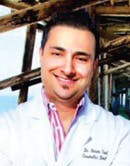Using technology in pediatric dentistry to instill a lifetime of compliant dental care
By Iman Sadri, DDS
RELATED | Technology in pediatric dentistry -- it's new to us!
As a general practitioner, what can be done to set up a positive, initial pediatric dental experience to instill a lifetime of dental compliance and regular dental checkups? One answer lies in 21st century dental technology.
1. The implementation of lasers for restorative treatment
One of the consistent challenges of pediatric cases without the utilization of sedation is the anesthetic process. Pediatric patients are often fearful, anxious, and restless when it is time for numbing. But what if restorative treatment can be performed without the infamous needle? Advances in technology using dental lasers that cut hard tissue have made it possible to remove decay and affected tooth structure with little to no anesthetic. A common psychological impediment in pediatric dental care among very young patients is the perceived misconception that dental treatment is punishment for negligence. The anesthetic process and the noise of the dental drill are two common factors feeding the fear of dental treatment. The utilization of lasers in restorative dentistry can help prevent both of these factors. In common instances, laser dental treatment to remove decay can be performed without any anesthetic, especially if the decay is not too deep into the dentin.
2. Dental education with child-friendly videos in the dental chair
The timeless dental adage as it relates to pediatric treatment is, "The dentistry is simple but the patient management is not." A common deterrent of effective patient management is inadequate communication. Child-friendly terminology using verbiage with phrases such as "sleepy juice" or "sugar bugs" may be well intentioned but may not be adequate to allow for full concession of treatment. Advances in technology have allowed for dental treatment videos to be shown to adult patients to educate them in "layman" terms as it pertains to their imminent procedure. For pediatric patients, animated videos with cartoonlike images for dental treatment can transfer effective communication otherwise lost in translation. Specific procedures such as composite restorations or basic oral hygiene can be shown with animation that is simple to follow and easy to understand. Software specific to patient education is readily available both online and through media catalogs. The advances in technology combined with the compassion and patience of the provider can help instill a lifetime of positive dental experiences and continuous dental visits.
Iman Sadri, DDS, is a cosmetic dentist and writer based in Orange County, Calif. He can be reached at [email protected].
Past DE Issues


